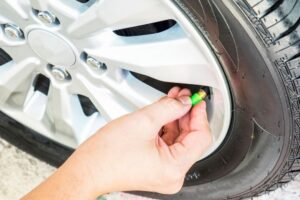Focusing on the little things is what matters most. In this case, we are talking about a small-cap on all tires, except the tubeless ones. These caps are the reason air stay inside the tires.
If you have noticed a green cap on tires instead of a regular one, then it means that the tire is using nitrogen instead of pressurized air.
Nitrogen should be the number one choice for tires because it is not stored at a higher pressure but keeps them inflated for much longer as when compared to air.
This article will be getting into the details of how nitrogen is superior to air, in all regards, and other information that is vital for you to know.
So, without any further ado, let’s get straight into it!
Table of Contents
Isn’t Normal Air Good Enough?

There is no problem with using regular air. It is more than adequate for your tires. And the best part is that it is completely free.
All you need is a pump, and you can inflate your tires without any difficulties.
The thing with air is that it tends to leak out slowly but gradually.
You may find yourself getting your tires inflated much more often when compared to better alternatives, such as nitrogen.
Doesn’t Air Already Contain Nitrogen?
Many of you may already know that air contains 78% nitrogen. The rest is oxygen and all other gases.
You may also be wondering if getting your tires filled with nitrogen is only a marketing tactic.
But the reality is quite the opposite. Pure nitrogen levels can cross the 90% range. They can get up to 95%, which means it is pure.
So, what is so special about it?
Well, I will list a research finding that will tell you why nitrogen is better. It has been found that when using nitrogen, the tire will deflate by around 2.2 PSI per year.
When talking about air, the number jumps up to 3.5! That is a noticeable difference, albeit not a huge one.
You may be asking then why nitrogen is better in this regard. Well, nitrogen particles are large, which makes them much denser when compared to air.
The density means that nitrogen molecules will move slower, reducing the wastage. I know this is getting too scientific, but please bear with me!
Advantages Of Nitrogen In A Tire
Before you go on ahead and fill your tires up with nitrogen, there are some main advantages that you need to know, which will further solidify the fact that it is better than air:
- The pressure is much more distributed, which stabilizes the vehicle and allows for better fuel efficiency.
- The increased pressure and density mean that the tires will become much stiffer. This will improve the handling, but not by a huge amount.
- Unlike air, which has water present in it in water vapors, nitrogen does not contain any such thing. The benefit of this is that the water will not cause any rust.
A combination of oxygen and water in a compressed area causes damage to the aluminum from the inside.
Disadvantages Of Nitrogen
The only disadvantage of nitrogen is the cost. As air is typically free or costs a few cents, nitrogen can get much more expensive.
This is because storing and extracting pure nitrogen is a costly process, unlike air, which can be utilized anytime and anywhere.
Do I Need To Use Nitrogen With My Vehicle?
It is not compulsory to use nitrogen in your vehicle’s tires, but it is definitely worth it if you are willing to pay the extra amount of cash.
The list of advantages has been listed above for those who are quickly scrolling through this article.
If you own a high-end vehicle, then you should make sure to not only maximize its lifespan but its performance too.
Nitrogen is the answer you are looking for, as far as your tires are concerned.
After all, who does not want a smoother and stabler driving experience?
Importance Of The Valve Cap
You may already be aware of a stem that pokes out of the tire. You connect the pump to it in order to inflate the tire.
You may have also noticed that there is a valve cap on top, which should only be removed when refilling the air. After the process, it should be put back.
So, what is the importance of this tiny part?
Well, the tires of a vehicle are the parts that suffer the most abuse. They have to drive through different terrains, in the mud and the rain.
Without the valve cap, the stem can get compromised. It can get blocked, or worse. The blockage will not allow you to fill the tire with air.
The cap prevents all that. It takes all the beating in order to make sure that the stem will remain clean and clear.
Whether it be air or nitrogen, without the cap, the stem will slowly but steadily also lose air.
If you did misplace one, then you may have noticed that one of your tires needs a top-up much quicker than the other ones.
This is dangerous, especially when driving at high speeds. A sudden flat tire can cause a fatal accident.
So, if you notice that the cap of anyone tire is missing, you need to buy a replacement ASAP.
Removing The Tire Cap
Removing the cap is not easy, and it definitely cannot be done by hand. You need pliers for the job. This ensures that it won’t fall off or unscrew due to vibrations.
Using pliers, you need to turn the cap until it becomes loose. Then you have access to the stem, which should be neat and clean.
Where Do I Get Nitrogen For My Vehicle?
So, you have finally made up your mind and agree with the fact that nitrogen is better than air.
Some of you may want to try it out before believing. Well, thanks to the ever-growing popularity of this gas, it is starting to become available at many places.
All tire dealers sell them. You can also go to an authorized dealership to purchase it.
If none of these are available in your area, then you can head on to a local retailer, such as Costco, to purchase it.
It is not necessary to get a whole canister of the gas. You can just get your tire refilled with it.
As dealers may not know what you are using currently in your tire, it is better to clarify it beforehand.
If the tire is currently using air, then you need to deflate it completely. Adding nitrogen on top of the air will do you no good.
Checking The Air Pressure
If you are a hardware enthusiast, then you should have a gauge in handy. It allows you to tell the exact pressure in the tire of your vehicle.
If it is 5 PSI below the maximum limit, then you are due for a refill. You should not cross the limit provided by the manufacturer.
Maximum Pressure Limit Of The Tire
Another question arises, what is the maximum pressure limit of my tire? Well, that depends on the vehicle to vehicle. If you have changed tires, you don’t need to refer to the tire’s manual.
You need to consult the vehicle’s manual instead. If you don’t have that handy, then the information will be provided on a sticker that is present on the doorjamb of your car.
Maximum Pressure Limit Of The Tire Is Mentioned On The Sticker
There is one other thing that you need to know. Although it varies from automaker to automaker, the pressure limit present on the sticker can be the maximum limit of the tire.
You need to make sure that you are below this range. Yes, this is true! The maximum limit of a tire and the approved limit are completely different things.
If you are not sure about which one it is, then you need to ask a professional or Google for help.
Why is this important?
The next few lines will make it clear to you exactly why we should never fill a tire up to its brim.
The reason for this is that vehicle tires get extremely hot when driven for long amounts of time.
So, if the air pressure present is completely filling the tire, its expansion can cause the tire to rupture. This can cause a crash, which can be fatal for you and other vehicles around you.
So, it is recommended to stay below the limit to ensure that the gas you are using has enough headroom to expand.
The Use Of The Green Cap
If you want to make sure that a tire shop knows automatically which gas you are using in your tires, it is better to install green caps.
These caps can be purchased from the same vendors. When you shift from air to nitrogen, you may need to ask for new caps.
After the refilling process is done, all you need to do is to install the new caps and discard the old ones.
Next time, people will be able to automatically recognize what was used to refill your vehicle.
Conclusion
If you were wondering what the green cap on tires was, then I hope that you got the answer you were looking for.
The article was much longer than many of you may have anticipated because of the fact that you need to get the absolute best. And the only thing that fits this category is nitrogen.
It not only leaks much slower than air, but it can actually affect the driving experience of your vehicle. You may even notice better fuel efficiency.
Although it does cost a bit more, nitrogen is definitely worth it.
So, if you have the chance, it is my recommendation to go ahead and shift from air to nitrogen. You will certainly not want to go back!

I am Tahir Azam, and I have been writing amazing articles for TaxiHack for as long as I can remember. I know everything that is to know when it comes to automobiles and is always on top of industry news and developments. While I am not an expert by any means, I pride myself on knowing the ins and outs of many different problems and, of course, their solutions. The articles on our website are some of the best and well-researched content that you will find, and I spend countless hours making sure this remains to be true. This is why I ask you to take your time out and read some of my articles, especially if you find a topic that resonates with you or is something you are looking into. This way, you will find the perfect mix of information and tips on your desired topic. Learn more about Tahir.



